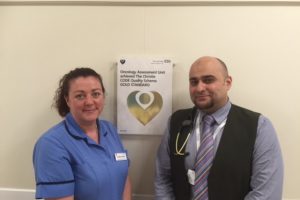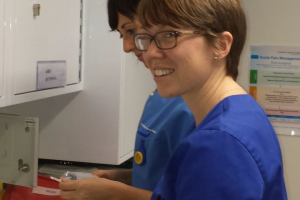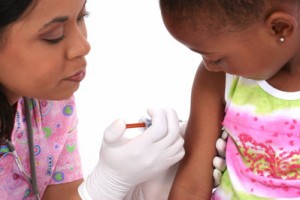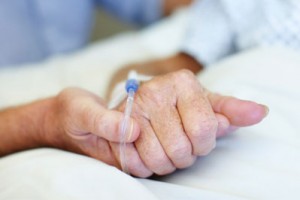Case studies
Complex co-morbidities – community acquired acute kidney injury
Share this on – Facebook / Twitter / Linked In

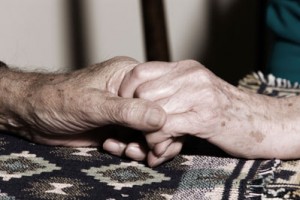
Mr R was a 72 year old man with hypertension, chronic kidney disease (CKD) and type two diabetes complicated by peripheral neuropathy. He had a BMI of 29. Mr R lived with his wife and was under regular review. He had been seen six months earlier by the practice nurse who had identified no new problems and had simply organised blood and urine tests. His blood pressure was noted to be stable and satisfactory at 134/80. An HbA1c was 64 mmol/mol, serum creatinine 144 umol/L (eGFR 44 ml/min/1.73m2) with no microalbuminuria. No changes were made to his medications which included Ramipril, Furosemide, Mixtard-30, Simvastatin, Paracetamol; Tramadol and Gabapentin. Mr R was reassured that his glycaemic control was satisfactory and that the rest of his blood tests were normal for his age.
His wife contacted the out of hours GP service via NHS 111, one Saturday afternoon because he had not been himself for a few days and was complaining of fatigue and malaise. He was also off his food. A telephone consultation ensued during which the on call GP established that he was managing a few cups of tea and some toast and that there was no history of chest pain, palpitations or cough, fever, abdominal pain, diarrhoea or vomiting or urinary symptoms. As his home blood glucose readings were high, diabetic sick day rules were discussed. The GP thought that a viral illness was the likeliest diagnosis. Rest, fluids and a regular carbohydrate intake were recommended with advice to monitor blood glucose frequently and to contact his surgery if still unwell after the weekend.
A home visit was requested by his wife on Monday as Mr R remained unwell and lethargic. He was still not eating or drinking very much. He was seen by a GP that lunchtime who noted that he was pale and afebrile with a blood pressure of 92/50. He also noted that Mr R’s right big toe looked infected. A two week course of Flucloxacillin was prescribed. A district nurse review was arranged in five days with repeat GP review in two weeks. There was no district nurse entry in Mr R’s record.
A further GP home visit was requested by his wife a week later as Mr R had been vomiting for 24 hours and was experiencing hypos. He was seen by another doctor who noted that Mr R was disorientated, agitated and unwell but afebrile and the red toe redness had settled. His blood pressure was 70/40. Urgent admission was arranged.
Admission: On admission he was found to be in hypovolaemic shock with oliguria. His admission serum creatinine was 480 umol/L with accompanying serum potassium of 7.1 mmol/L. He was resuscitated with IV fluids. Ramipril, Furosemide, Tramadol and Gabapentin therapy were temporarily suspended.
Final Diagnosis: Stage three Community acquired Acute Kidney Injury secondary to hypovolaemia
Outcome: This patient recovered his baseline renal function but died four weeks after discharge from an acute myocardial infarction.
Who would the learning opportunities be relevant to?
- GPs, GP registrars
- Allied Health Professionals working in a primary care setting
Key Learning Opportunities
- Multiple risk factors for acute kidney injury are now known to include advanced age and diabetes mellitus, but the most important risk factor is pre-existing CKD which increases risk by as much as ten times, compared with the absence of CKD. So it is important for patients to be aware of their CKD status to enable them (and other health professionals) to manage their risk and make informed decisions about their care.
- The normal capacity of the kidney to auto-regulate GFR in the face of fluctuations in blood pressure is impaired in CKD (as well as in elderly patients, those with diabetes, atherosclerosis or hypertension) and is further compromised by the use of drugs such as ACE inhibitors (ACEi) and Angiotensin receptor blockers (ARBs) or NSAIDS. Hypotension as a result, for example, of hypovolaemia or sepsis may therefore cause an acute decline in GFR in patients with CKD taking drugs such as ACEI or ARBs. Thus, avoiding NSAIDS, reducing the dose or holding off diuretics and ACEi or ARBs until recovery is sensible in these patients.
- Hypovolaemia associated with any type of insult including dehydration or over-diuresis is probably the most modifiable risk factor for acute kidney injury. It is worth noting that patients who are off food and drink and remain on their usual doses of diuretics are at particular risk of hypovolaemia. This is because a decreased salt intake and on-going salt losses can lead to a progressive negative sodium balance with a downward shift in blood pressure.
- Assessment of volume status for patients experiencing acute illness in the community requires the clinician to be aware of CKD status and all prescribed and over the counter medications such as ACEi, ARB, NSAIDS and diuretics. Assessment should also include questions on fluid intake and output with a physical examination and renal function tests conducted in the context of the patient’s clinical history. Note, however, that patients may develop oliguric as well as non-oliguric acute kidney injury.
- The development of absolute hypotension (systolic blood pressure less than 90 mmHg) is a clinical red flag. An unexpected fall of 40 mmHg from a previous base-line is however, also significant. Such a drop should trigger review of anti-hypertensive drugs even if blood pressure remains within the normal range.
- Kidney disease significantly alters insulin metabolism and insulin doses may need adjusting. In addition, certain renally excreted drugs such as opoid analgesics, digoxin, metformin and specific anticonvulsants (including those used for neuropathic pain such as Gabapentin) can accumulate in patients with deteriorating renal function and cause untoward effects.
From which Clinical Perspective?
- Primary care/Laboratory
Case studies










